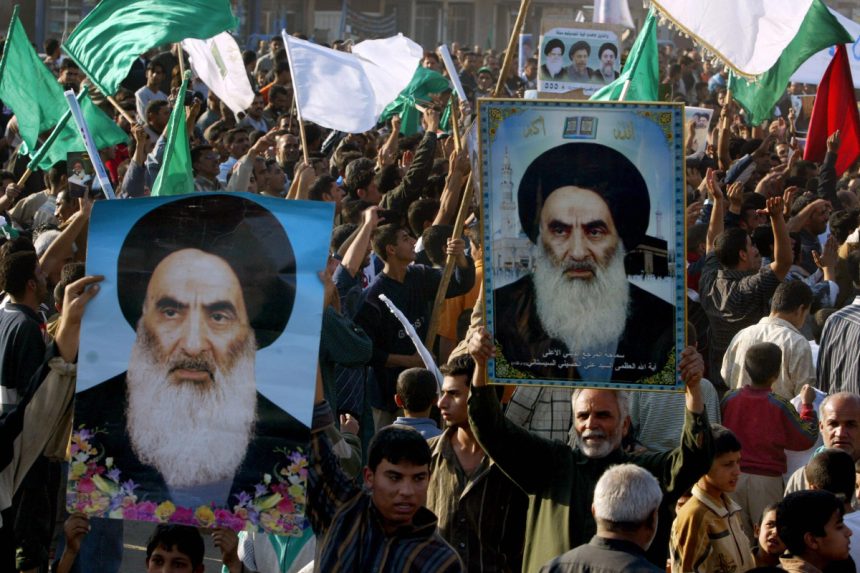When a religious scholar in Iran issued a proclamation that pushed Iraq to the brink of civil war last week, there was only one man who could stop it: a 92-year-old Iraqi Shi’ite cleric who demonstrated again that he is the most influential man in his country.
Grand Ayatollah Ali Al-Sistani made no public comments on the rioting on Iraq’s streets. However, according to government officials and Shi’ite sources, it was only Sistani’s stance behind the scenes that prevented a breakdown.
The story of Iraq’s bloodiest week in over three years demonstrates the limits of traditional politics in a country where clerics wield the authority to launch and end conflicts, many of whom have dubious relations with Iran, the Shi’ite theocracy next door.
The Iraqis who took to the streets blamed Tehran for inciting the unrest, which erupted when an Iranian-based cleric criticized Iraq’s most popular politician, Moqtada al-Sadr, and directed his followers, including Sadr, to seek advice from Iran’s Supreme Leader.
Sadr’s supporters attempted to storm government buildings. They were driving around Baghdad in pickup trucks armed with machine guns and bazookas by dusk.
Armed men thought to be pro-Iranian militiamen opened fire on Sadrist demonstrators throwing stones. Around thirty people were killed.
And then, within 24 hours, it ended as abruptly as it had begun. Sadr returned to the airwaves, this time calling for calm. His armed supporters and unarmed followers began to leave the streets, the army removed a nocturnal curfew, and the capital fell into a fragile peace.
Reuters interviewed over 20 officials from the Iraqi government, Sadr’s organization, and rival Shi’ite forces seen as pro-Iranian to learn how the unrest began and how it was put down.
All of the interviews pointed to a strong involvement behind the scenes by Sistani, who has never held formal political office in Iraq but is the most powerful academic in the country’s Shi’ite religious center, Najaf.
According to the officials, Sistani’s administration made it clear to Sadr that unless Sadr and his followers stopped the violence, Sistani would condemn the uprising.
“Sistani sent Sadr a message that if he does not halt the violence, Sistani will be compelled to issue a statement calling for a cease-fire – this would have made Sadr look weak, and as if he had caused bloodshed in Iraq,” an Iraqi government official said.
Three Shi’ite individuals in Najaf close to Sistani refused to accept that Sistani’s administration delivered Sadr an explicit communication. They stated it would have been evident to Sadr that unless Sadr called off the unrest, Sistani would come out soon.
According to one Iran-aligned figure in the region, “Moqtada al-Sadr would not have held his news conference” that ended the conflict if Sistani’s office had not existed.
For the time being, Sistani’s intervention may have prevented further violence. However, it does not address the issue of preserving calm in a country where the Shi’ite clergy wields so much authority outside the political system, particularly clerics with close ties to Iran.
Sistani, who has intervened decisively at critical junctures in Iraq’s history since the US-led invasion that deposed Saddam Hussein, has no clear successor. Despite his age, little is known about his current condition.
Meanwhile, many of the most powerful Shi’ite individuals, including Sadr at different stages in his career, have studied, lived, and worked in Iran, a theocracy that does not attempt to separate clerical influence from state power.
Last week’s unrest began when Ayatollah Kadhim al-Haeri, a high-ranking Iraqi-born Shi’ite cleric who has resided in Iran for decades, announced his retirement from public life and closure of his office owing to senior age. Such a decision is almost unheard of in Shi’ite Islam’s 1,300-year history when top clerics are traditionally honored till death.
Sadr’s father, Mohammad Mohammad Sadeq al-Sadr, a famous priest who was slain by Saddam’s dictatorship in 1999, appointed Haeri as Sadr’s movement’s spiritual counselor. In announcing his departure, Haeri condemned Sadr for generating schisms among Shi’ites and urged his followers to seek future religious guidance from Ayatollah Ali Khamenei, the cleric who also happens to be the Iranian state’s ruler.
Sadr made it apparent in public that he blamed Haeri’s interference on outsiders, implying Tehran: “I don’t believe he did this of his own volition,” Sadr tweeted.
Sadr was enraged, according to a senior Baghdad-based member of Sadr’s movement. “Sadr’s spiritual mentor was Haeri. Sadr perceived it as a betrayal intended at depriving him of his religious validity as a Shi’ite leader at a time when he is fighting for power against Iran-backed militias.”
Sadrist officials in Najaf said the move forced Sadr to choose between obeying his spiritual guide Haeri and following Khamenei, or rejecting him and potentially upsetting older figures in his movement close to Sadr’s father.
Instead, Sadr announced his exit from politics, prompting his supporters to take to the streets.
The Iranian government and Sadr’s office did not respond to requests for comment on this story right away. Haeri’s office could not be reached right away.
According to Shi’ite Islam experts, Haeri’s decision to close his own office and instruct his followers to support the Iranian leader would have appeared suspicious in an Iraqi culture where suspicions of Iranian influence are combustible.
“There’s a good case to be made that this was affected by Iranian pressure, but keep in mind that Haeri has had issues with Sadr in the past,” Harvard researcher Marsin Alshammary said.
“When there is no (religious) need, he refers followers to Khamenei. And it appears improbable that someone in his position would close his offices, which are most likely extremely profitable “She stated.
Sadr remained silent for nearly 24 hours while firefights raged in central Baghdad.
During that period, Shi’ite religious officials from across Iraq attempted to persuade Sadr to halt the violence. Shi’ite authorities from Iran and Lebanon joined them, according to officials in those countries, who said pressure on Sadr was channeled through Sistani’s office in Najaf.
“The Iranians are not directly intervening. They are stinging from the backlash against their involvement in Iraq and are attempting to influence events from afar “According to an Iraqi government official.
Baghdad was calm on Friday, but the standoff continues.
Sadr insists on new elections, while some Iran-backed organizations want to create a government right away. Clashes erupted late last week in oil-rich southern Iraq.
READ MORE: Execution of Tsar Nicholas and family by Bolshevik revolutionaries
The government has generally remained mute. In a statement issued hours after fighting had ceased, Prime Minister Mustafa al-Kadhimi warned he would resign if the unrest continued.
“Where, amid all of this, is the prime minister, the commander-in-chief?” Renad Mansour was asked. More violence was possible, according to Mansour.
“Sadr’s major goal is to become Iraq’s leading Shi’ite actor, thus he plans to go after his Shi’ite opponents. In Iraq, one of the strategies used to compete is violence.”






An exemplary diety to follow.
On point article.💖
Very authentic 👍🏻